How To Repair Large Areas Of Walls That Have
Planning & preparation
- A wall can become damaged for many reasons, but luckily carrying out repairs is relatively straightforward. Here we will show you how to patch repair a wall, as well as how to repair small and large holes in plasterboard
- Bear in mind that the application method can vary between products, so it's always best to check the manufacturer's instructions
- There are many different fillers and plaster products available, so be sure to consider the range and select a product that is best suited to your job. For example, if you only need a small amount, you might find it easier to use ready mixed plaster
- Thorough preparation is key to achieving a high-quality finish, so be sure to remove all traces of old plaster, dust and grease for the area you plan to repair
- Lay out protective sheets to cover the floor and any nearby furniture
- Turn the radiators off in the room so the plaster doesn't dry out too quickly
- Some plaster products shouldn't be applied to a depth of more the 12mm in one go. If this is the case, you may need to make two or more applications
- Most plasterboard comes in either 9.5mm or 12.5mm thickness, so try to replace like-for-like when making repairs
- Have a bucket of water to hand when working so you can clean your trowel as you need to; this will help to avoid lumps and unnecessary work
- For more advice, see our online guides or leaflets 'How To Plaster a Wall' and 'How To Prepare Walls & Ceilings for Decorating'
Do it right
- When working with plaster, it's best to only work with small amounts on the hawk and trowel. Try to build up a rhythm so you can cover the patch repair before the plaster starts to set
- Plaster can dry out quickly, so don't mix up to too large a quantity at any one time
Staying safe
- If sanding plaster or cutting plasterboard, be sure to wear goggles and a dust mask and try to work in a well-ventilated space
- Always use a cable, pipe & stud detector before cutting or sawing into areas you're repairing
- When mixing or applying plaster, wear safety goggles, a dust mask and protective gloves
Aftercare
- Allow the plaster to dry naturally, so avoid putting your heating on high for a few days
- To prepare the surface for painting, sand with a fine grade sandpaper
- If you are planning to paint the wall, it's a good idea to apply a sealer or primer paint to help your finishing paint to adhere
Patch repair plaster to solid walls
Remove any damaged or loose plaster with a scraper. Then, use a wire brush to clean the area.
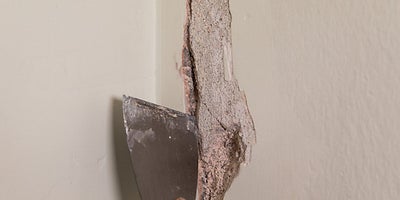
Thoroughly dampen the surface surrounding the repair with a mix of PVA glue and water.
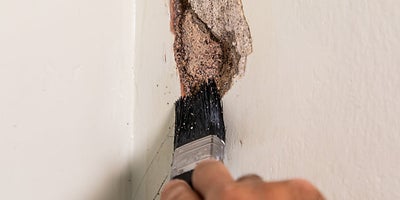
Following the manufacturer's instructions, mix the quick-drying patch plaster.
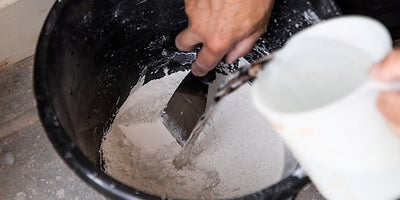
Using a plastering trowel, transfer a section of plaster to the plasterer's hawk.
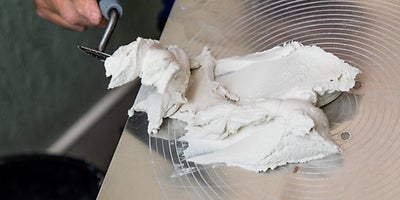
Cut a small section of plaster onto the plastering trowel and apply to the repair with vertical and horizontal movements. Press firmly to work the plaster into the damaged area.

Following the manufacturer's instructions, leave the plaster to dry. Once the plaster is dry, use a spray gun or paint brush to dampen the surface with clean water.
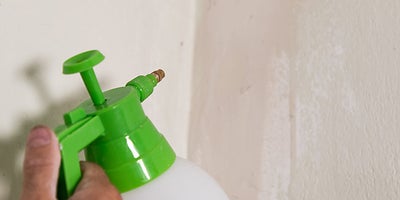
Using the edge of a clean trowel, work across the plaster repair to smooth the finish. Repeat this process if advised by the manufacturer.
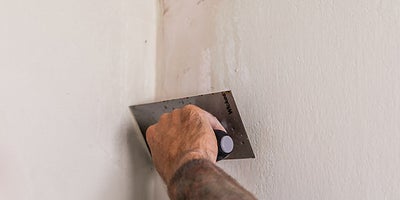
Repair small holes in plasterboard
Check the area around the repair with a cable, pipe & stud detector to make sure it's safe to cut through the old plasterboard.
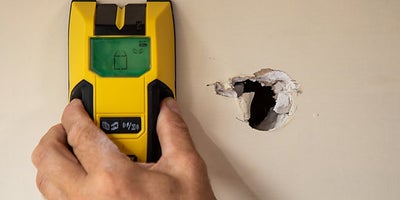
Measure the hole then clearly mark the measurements onto a piece of plasterboard offcut.
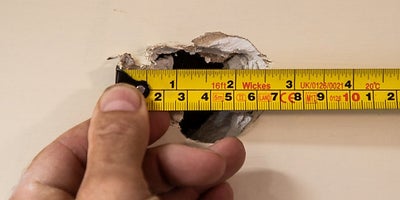
Add an extra 25mm at the top and bottom, then cut the offcut to size with a plasterboard saw or retractable knife.
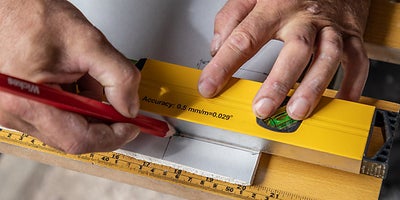
Using a pencil and straight edge, mark the original measurements (without the additional 25mm overhangs) onto the wall.
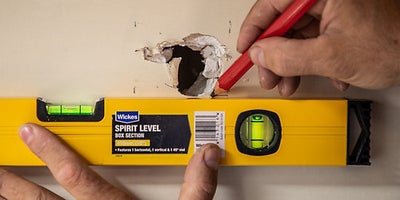
Draw diagonal lines from the hole into each corner. Then, use a plasterboard saw to cut along the diagonal lines.
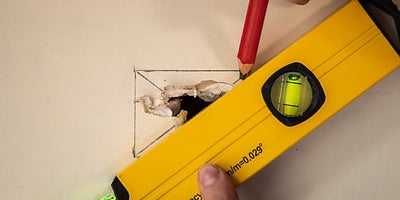
Using a retractable knife and straight edge, score the plasterboard along the guide marks and remove the excess plasterboard.
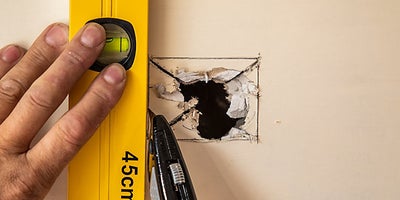
Drill a hole that is big enough to easily accommodate a nail into the centre of the plasterboard offcut. Then place a nail into the hole.
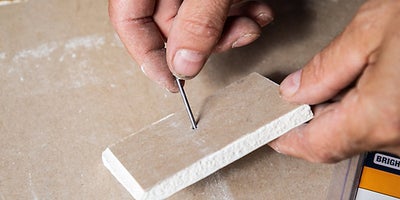
Apply a bead of grab adhesive to the 25mm overhang at the top and bottom of the offcut and carefully slide the offcut through the hole and into position.
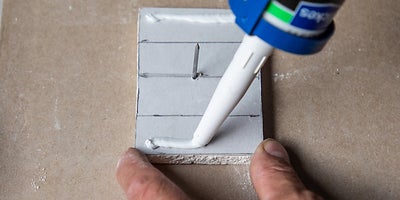
Pull the nail towards you to create a strong bond between the adhesive and the plasterboard. Don't let go of the nail until the adhesive has bonded. Allow the adhesive to dry fully before continuing.
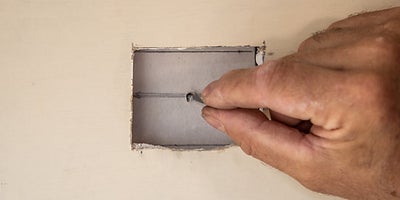
Once the adhesive has dried, push the nail out so it falls behind the plasterboard.
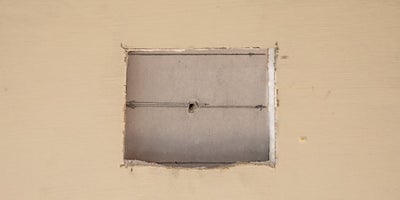
Mix and apply the repair plaster or ready mixed filler. Apply to the hole with a flexible filling knife, working both vertically and horizontally and ensuring you fill the hole until level with the plasterboard.
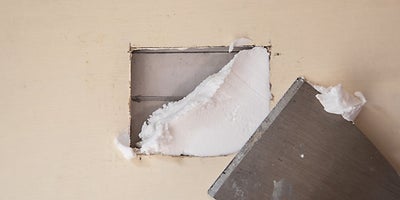
When dry, use medium grade sandpaper and sanding block to create a smooth, level finish.
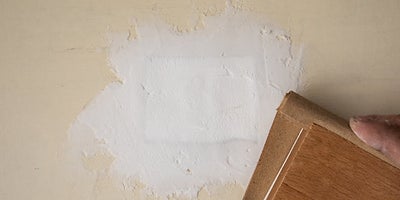
Repair large holes in plasterboard
To make sure it's safe to work, check around the repair area with a cable & pipe detector.
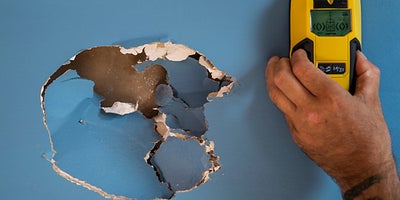
Use a stud detector or place a metal ruler inside the hole to locate the position of the studs on both sides. Mark roughly where the centre of the studs are onto the plasterboard wall.

Using a straight edge or spirit level, extend the marks and draw vertical lines that run higher and lower than the damaged area.
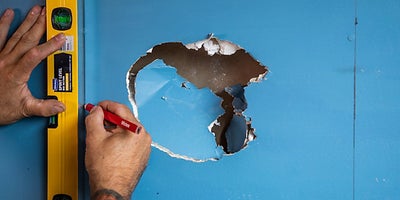
Then, draw horizontal lines 50mm above and below the damaged area, so they join to the vertical lines and create a rectangle.
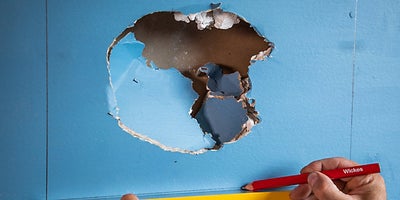
Mark diagonal lines into each corner and cut along them with a plasterboard saw.

Use a retractable knife and straight edge to score along the horizontal and vertical lines so you can remove the entire damaged area.
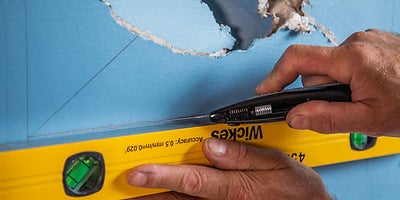
Measure the distance between the two studs and cut two lengths of batten to size.
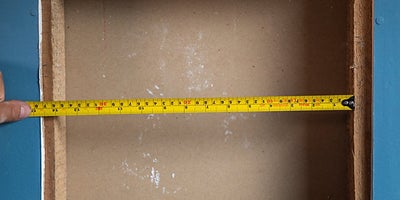
First, drill the pilot holes. Then, using a combi-drill, secure the batten in position by skewing 40mm screws through the batten and into the studs to create support noggings at the top and bottom of the hole.

Carefully measure and cut a section of plasterboard to fit the space.
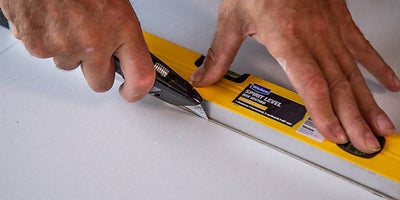
Attach the section of plasterboard to the studs and noggings with 32mm drywall screws.

Then, secure the original plasterboard to the studs and noggings with 32mm drywall screws.
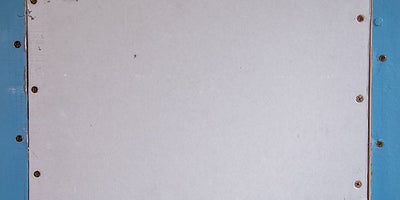
To help make the seam invisible and to prevent future cracking, carefully apply jointing tape, so that the tape overlaps the join.
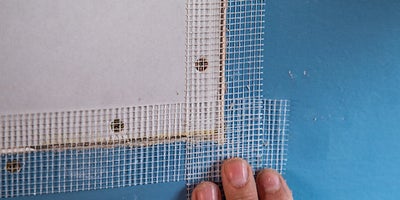
Following the manufacturer's instructions, mix the finishing plaster. Apply it with a plasterer's finishing trowel, ensuring all the jointing tape is covered.
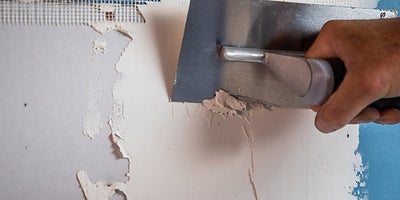
Allow to dry and then use medium grade sandpaper and a sanding block to create a smooth and level surface.
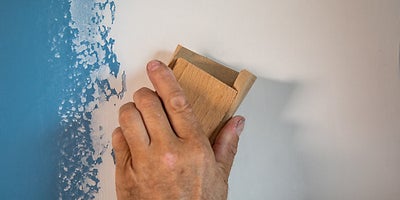
How To Repair Large Areas Of Walls That Have
Source: https://www.wickes.co.uk/how-to-guides/home-maintenance/repair-a-wall
Posted by: mannfoomescree.blogspot.com

0 Response to "How To Repair Large Areas Of Walls That Have"
Post a Comment